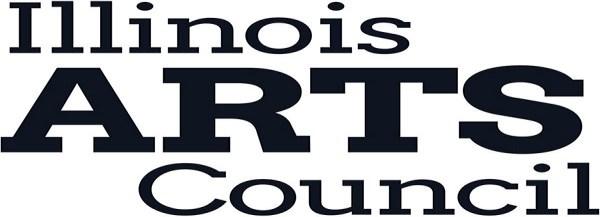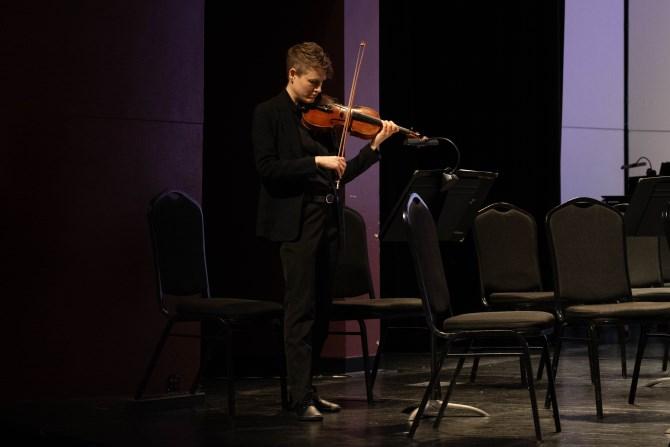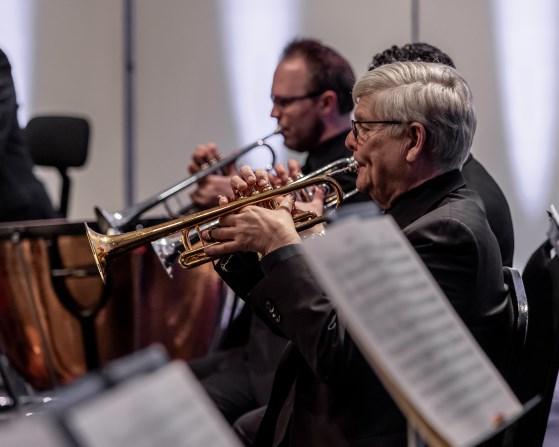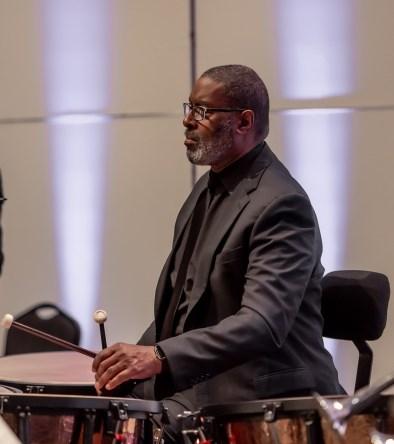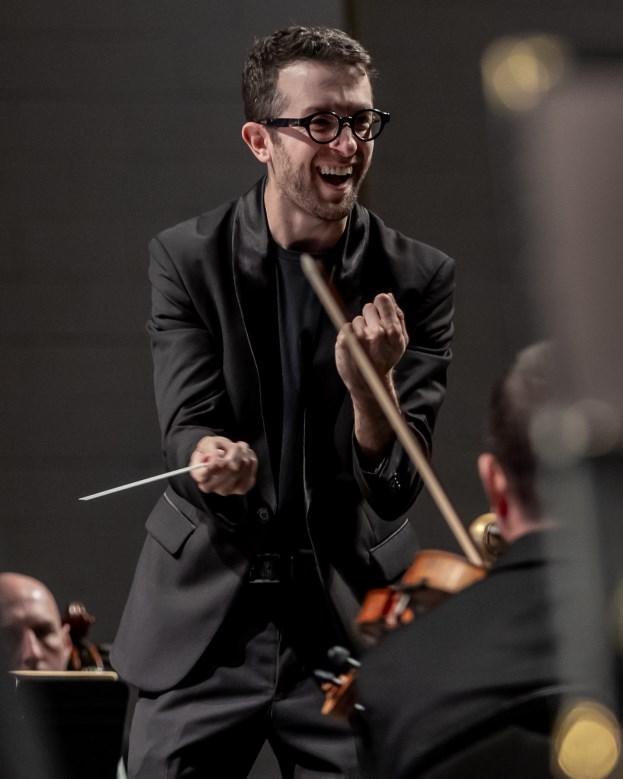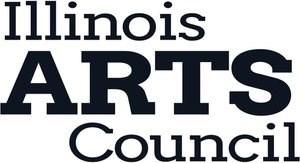ORCHESTRA PERSONNEL/PERSONAL DE LA ORQUESTA
Violin I
Isabella Lippi
Concertmaster
Eleanor Bartsch**
Associate Concertmaster
Gerald Loughney
Kate Carter
Eric Pidluski
Joseph Malmquist
Susan Carlson
Carol Dylan
Helen Kim Lee
Wendy Evans
Carmen Abelson
Jennifer Leckie
Violin II
Daniela Folker
Principal
Robbie Herbst
Assistant Principal
Caroline Slack
Maria Arrua
Susan Thorne
Steve Winkler
Cristina Buciu
Elizabeth Huffman
Kelvin Lin
Meg Lanfear
Kathryn Siegel
Viola
Rebecca Swan
Principal
Loretta Gillespie
Assistant Principal
Josef Fischer++
Jason Butler
Erin Rafferty
Sava Velkoff
Susan Posner
Cello
Matthew Agnew
Principal
Nazar Dzhuryn
Assistant Principal
Kerena Fox
Mark Kuntz
Robert Weber
Elizabeth Start
Sara Sitzer
Double Bass
Timothy Shaffer**
Principal
Jeremy Attanaseo
Assistant Principal
Susan Sullivan
Greg Heintz
Jason Niehoff
Adam Attard++
**On Leave 2024-2025
++Season Substitute
Flute
Jean Bishop
Principal
Scott Metlicka
Piccolo
Scott Metlicka
Oboe
James Kim
Guest Principal
Joseph Claude
English Horn
Joseph Claude
Clarinet
Gene Collerd
Principal
Trevor O’Riordan
Bassoon
Vincent Disantis
Principal
Collin Anderson
French Horn
Greg Flint
Principal
Steven Replogle
Sharon Jones
Mary BuscanicsJones
Trumpet
Ross Beacraft
Principal
Michael Brozick
David Gauger
Assistant Principal
Trombone
Reed Capshaw
Principal
Adam Moen
Bass Trombone
Mark Fry
Tuba
Charles Schuchat
Principal
Timpani
Robert Everson
Principal
Percussion
Brian Oriente
Principal
Michael Folker
Harp
Lillian Lau
Principal
Keyboard
Patricia Lee Principal
Violin
Extra Musicians
Laura Burns, Emily Nash, Sally Stephenson, Pam Lutter, Erik Liljenberg, Nina Saito, Sam Battista, Christie Abe
Viola Robert Switala, Nick Munagian, Rebecca Miller
Cello Larry Glazier
Bass Lauren Pierce, Hannah Novak, Weldon Anderson, Bennett Norris
Flute Eliza Bangert, Maria Schwartz
Oboe Will Stevens, Hannah Fusco
Clarinet Jennifer Woodrum, Patrick Rehker
Bassoon William George, Nathaniel Hale
Saxophone Joseph Connor
Horn Mary Jo Neher, Parker Nelson, Peter Jirousek
Trumpet John Burson, Paul Semanic
Percussion Tina Laughlin, Brandon Podjasek, Josh Jones, Paul Ross, Collin Boltz
Stage Managers David Goldman and Eric Block
ADMINISTRATION/ADMINISTRACIÓN
Chief Executive Officer, Marc Thayer
Vice President of Artistic Planning & Operations, Eric Gaston-Falk
Director of Finance & Administration, Rebecca DeWane
Director of Marketing, Chuck Kocal
Director of Development, Leslie Antoniel
Corporate Development Manager, Betty Briceño
Community Partnerships & Orchestra Personnel Manager, Greg Heintz
Development Coordinator, Jonathan Horn
Patron Services Manager, Luiza Moraes
Public Relations Manager, Donna Lake
Box Office Manager, Erica Warszewik
In Harmony Program Coordinator, LaTrisha Williams
Translator, Elsa Jimenez
Carmen Abelson, violin
Ross Beacraft, principal trumpet
Robert Everson, principal timpani
MUSIC DIRECTOR / DIRECTOR MUSICAL
Chad Goodman has received widespread praise for thrilling conducting that combines “precision, agility and fervor” (N. Stanić Kovačevic, South Florida Classical Review) and for displaying the “pitch perfect combination of abandon and subtlety” (L. Budman, South Florida Classical Review)
The 2024/25 season marks Goodman’s 2nd season as Music Director of the Elgin Symphony Orchestra only the fifth leader in the orchestra’s prestigious seven-decade history. Concerts with the ESO include Tchaikovsky’s Symphony No.6, Beethoven Violin Concerto with Stella Chen, Sibelius Symphony No. 5 coupled with Tchaikovsky's Violin Concerto performed by Samuel Vargas and Holst’s masterpiece, The Planets.
Goodman holds a Bachelor of Music degree from the Eastman School of Music and a Master of Music degree from San Francisco State University. His mentors include Michael Tilson Thomas and Alasdair Neale.
GUEST ARTIST/ARTISTA INVITADA
Ana Vidovic is known for her beautiful tone, precise technique, well-defined phrasing and thoughtful artistry and musicianship. In Summer, 2024, Ms. Vidovic toured Japan and performed with orchestra at Classical Tahoe (NV). Her 2024-25 season is highlighted by solo recitals at New York City’s 92nd Street Y, and in San Francisco and Austin. Concerto engagements include Elgin Symphony, Stockton Symphony (CA), SW Utah
Symphony and Victoria Symphony (TX). In Europe, Ms. Vidovic will tour with Cuarteto Casals as well as appear in recital in Split, Croatia; Bad Aibling and Hamburg, Germany; and Copenhagen. She will perform with orchestra at Opéra de Rouen Normandie (France).
Ms. Vidovic has won an impressive number of prizes and international competitions including first prizes in the Albert Augustine International Competition in Bath, England, the Fernando Sor competition in Rome and the Francisco Tarrega competition in Spain. In Croatia, the guitarist has performed with Symphony Orchestra of the Croatian Radio and Television, as well as having been featured in three television documentaries by the eminent Croatian film director Petar Krelja. Ana Vidovic comes from the small town of Karlovac near Zagreb, Croatia, and started playing guitar at the age of 5. Ms. Vidovic’s reputation in Europe led to an invitation to study at the Peabody Conservatory from which she graduated.
PROGRAM NOTES
Written by - Daniel Maki
Kauyumari
Gabriela Ortiz (b. 1964)
Gabriela Ortiz has built an impressive career as one of the most important figures in the music of her native Mexico. She was born in Mexico City to parents who were founding members of the renowned group Los Folkloristas, an ensemble dedicated to performing Latin American folk music. In addition to playing guitar and charango (an Andean member of the lute family of stringed instruments) in her parents’ ensemble, she received a varied music education, including classical piano study and composition with renowned Mexican composers such as Mario Lavista and Federico Ibarra. She continued her studies in Europe, including work at the École Normale de Musique in Paris and a PhD at the University of London.
As her multi-faceted early musical experiences might suggest, her impressive body of works combines influences from art music, jazz, and folk music. She has received commissions from many leading musical organizations including the Los Angeles Philharmonic, the New York Philharmonic, the Cincinnati Symphony Orchestra, the Simón Bolivar Symphony Orchestra of Venezuela, and the Royal Liverpool Philharmonic. Among her many awards have been the National Prize for Arts and Literature, the John Simon Guggenheim Memorial Foundation Fellowship, the Fulbright Fellowship, and two Latin Grammy nominations. She teaches at Mexico’s National Autonomous University and has been a member of the faculty at Indiana University.
Kauyumari was commissioned by the Los Angeles Philharmonic and was premiered by that ensemble in October of 2021 under conductor Gustavo Dudamel. Like many of her works,
Kauyumari draws on Mexican folk culture for its inspiration. Among the Huichol people of Mexico Kauyumari means “blue deer,” referring to a divine creature that serves as a spiritual guide. As Gabriela Ortiz explains in her own program notes, the deer “is transformed through an extended pilgrimage into a hallucinogenic cactus called peyote. It allows the Huichol to communicate with their ancestors, do their bidding, and take on their role as guardians of the planet.”
The commission from the Los Angeles Philharmonic included the request to write music that would reflect the fact that the orchestra was returning to public performance after the pandemic had receded. The composer has said that upon hearing that request, she immediately thought of the blue deer and “its power to enter the world of the intangible as akin to a celebration of the reopening of live music.” The new work would demonstrate the power of music to bring human beings together after a long absence.
Kauyumari is a brief but skillfully constructed, colorfully orchestrated, and rhythmically exciting work based on a Huichol melody that she had already used in another work. This melody is systematically repeated and developed until it becomes almost unrecognizable,
Illustrating, according to the composer, “the imaginary effect of peyote and our awareness of the invisible realm.”
* *
Suites Nos. 1 and 2 from El sombrero de tres picos (The ThreeCornered Hat)
Manuel de Falla (1876-1946)
It’s become something of a cliché that some of the best Spanish music was written by non-Spaniards. Manuel de Falla’s lifework might be described as an attempt to rectify that situation. After enjoying a golden age during the Renaissance, Spanish music had suffered a decline that lasted some three centuries, and it was not until the late nineteenth century that a nationalist revival again put Spanish music on the international stage. Falla became the leading figure of this new renaissance, producing a distinguished body of work which demonstrated the most sophisticated techniques of European music, especially French Impressionism, yet also remained thoroughly Spanish in flavor.
The ballet The Three-Cornered Hat remains one of Falla’s most popular works. Based on the novel El sombrero de tres picos by Pedro de Altarcon, it was originally conceived as a pantomime entitled The Corregidor and the Miller’s Wife. The premiere in Madrid in 1917 was a great success, and soon after, the music came to the attention of Sergei Diaghilev, the legendary impresario of the Ballets Russes. Diaghilev had already midwifed some of the twenti-
-
eth century’s greatest music, including ballets by Stravinsky, Debussy, and Ravel. His incomparable nose for excellence served him well again as he persuaded Falla to turn the pantomime into a full-length ballet. The premiere took place in 1919 in London with dancing by such luminaries as Karsavina and Massine, and sets and costumes by a certain Pablo Picasso. The rest, as they say, is history.
Very briefly put, the farcical plot concerns a young miller, his pretty wife, and the strenuous exertions by the pompous, muddle-headed, and lecherous corregidor (a kind of local official who wears a three-cornered hat) to seduce her. The selections heard today are the most popular excerpts from the full score.
I. After a brief opening fanfare we are given a warm, Andalusian afternoon in which the corregidor leads a pompous procession near a mill. (A bassoon solo depicts the procession.)
II. The miller takes a dislike to the corregidor and has his wife dance a sensuous fandango to tantalize him.
III. After the dance we again hear the bassoon representing the corregidor strutting about.
IV. The wife coquettishly tempts the corregidor with some grapes. She runs away from the corregidor, who, in pursuing her, falls into an ambush and is chased away by the husband brandishing a stick. Act I ends.
V. The Neighbors’ Dance At the beginning of the second act, neighbors join the miller and his wife to celebrate St. John’s Day, the longest day of the year. There is general rejoicing as they dance a seguidilla, a dance originating in southern Spain.
VI. The Miller’s Dance As part of the festivities the miller shows his skill by dancing a farruca, a flamenco dance with much fiery foot stomping.
After much preliminary casual flirting with the miller’s wife, the corregidor has finally gotten down to serious business and had the miller arrested on trumped up charges, thus clearing the way for his less-than-honorable intentions. As the wife tries to evade him, he slips into a creek. Having gotten out of those wet things, he makes himself at home in the connubial bedroom where he is
discovered by the miller, who has escaped from jail. Seeing the corregidor in the altogether, the miller not unreasonably assumes that his wife has betrayed him. He immediately resolves to do to the corregidor’s wife what he imagines has been done to his own, and thus puts on the corregidor’s clothes. The corregidor, on the other hand, dons the miller’s clothes and is soon arrested by his own police, who don’t recognize him.
VII. Final Dance
The poor reader who has followed all this hanky-panky can now relax and enjoy the brilliantly colorful Final Dance, which is a jota, a dance from the Aragon region of northeastern Spain. By the end, all misunderstandings have been cleared up, the gathered crowd is giving the nasty corregidor all the ridicule that he deserves, and the miller and his wife are preparing to live happily ever after.
Fantasia para un gentilhombre
Joaquín Rodrigo (1901-1999)
Joaquín Rodrigo is of course best known as the composer of the Concierto d’Aranjuez, the most popular of all guitar concertos, and, as sometimes happens in such cases, a work which is in danger of becoming a victim of its own success through overexposure. Rodrigo did write two other large scale works for guitar and orchestra which are well worth hearing, including the delightful Fantasia para un gentilhombre (Fantasia for a Gentleman) which was completed in 1954 and dedicated to the guitarist Andres Segovia. Rodrigo’s style, with its frequent reminiscences of Spanish music of the past, has been labeled neoclassical. This is particularly true of the Fantasia, which is based on the Instruccion de Musica (1674) by Gaspar Sanz, a priest who was composer and guitarist to Philip IV. This instructional method for guitar was of historical significance, being the most comprehensive such treatise of its time and widely imitated. Such pedagogical material can be deadly dull in terms of musical significance, but Sanz used interesting dances of the period. Rodrigo has kept the courtly period flavor of the originals while
allowing his own imagination full scope. As he neatly put it, the gentilhombre in question is, in equal measure, Segovia and Sanz.
The Fantasia is technically a suite rather than a concerto, and falls into four movements, each based on different dances. The opening movement is a nobly tuneful villano which eventually leads to a ricercar, a learned polyphonic style which served as predecessor to the fugue. The second movement falls into three sections, the first and last being an Españoleta, a slow, graceful dance which is here given a series of variations. In between, we hear Fanfares from the Kingdom of Naples, a reference to the fact that in the seventeenth century Naples was under Spanish dominion. This section is faster and contains several horn calls. The Españoleta then returns.
The third movement, entitled Danza de las hachas (Hatchet Dance), frequently divides the orchestra into strings and winds, the soloist siding with one group and then the other. The fourth movement brings the work to a rollicking conclusion with a canario, a dance originating in the Canary Islands.
Bolero Maurice Ravel (1875-1937)
In 1927 Ravel promised the distinguished dancer Ida Rubinstein that he would orchestrate some piano pieces by the Spanish composer Isaac Albéniz for use in a ballet on a Spanish theme. Much to Ravel’s annoyance, copyright issues interfered and he was forced to supply original music instead. Probably because time was short, he concocted the idea of a piece based on a single melody repeated time and time again, gradually building to a climax. The composer settled on “bolero” as a title, even though that Spanish dance is usually conceived of in a much faster tempo. In the ballet, the music was set in a Spanish bar, where la Rubinstein, dressed as a flamenco dancer, danced a seductive dance for the benefit of the male patrons. Beginning quietly, she ended up on a tabletop as the music built to an orgiastic frenzy. Bolero was a great success in the ballet, and, much to the composer’s surprise, in the concert hall as well. Although Ravel had never thought that it could stand alone as a concert piece outside the ballet, Bolero became a kind of cult orchestral piece,
attracting both passionate devotees and equally passionate detractors who called it a fraud on the public. Ravel was forced to publish a disclaimer in which he described it as a one-of- a-kind experiment consisting only of “orchestral tissue without music” and that it was there for “the listeners to take it or leave it.”
Once the exotic melody and hypnotically repeating rhythm have been heard, most of the interest of Bolero lies in its orchestration, an art of which Ravel was a supreme master. Timbre becomes almost an end in itself as new orchestral sounds are gradually added. Bolero might also be heard as a forerunner of minimalism, that currently fashionable style based on the “less is more” principle of systematic repetition of simple musical ideas. It should also be noted that, except for a brief excursion near the end to E major which even the untutored ear can easily detect, Bolero is entirely in C major, something which traditional compositional practice would have considered monotonous to the point of lunacy.
Bolero received a notoriety which it perhaps did not need in the 1979 film, 10, starring Bo Derek and Dudley Moore, in which the music again served its original purpose of aphrodisiac. The music continues to fascinate in the concert hall, even without the seductive charms of Mesdames Rubinstein and Derek.
SEASON SPONSORS

